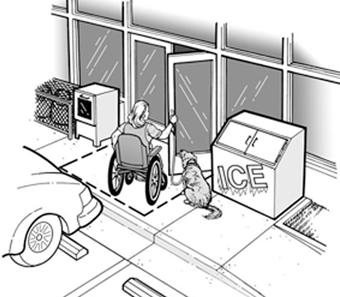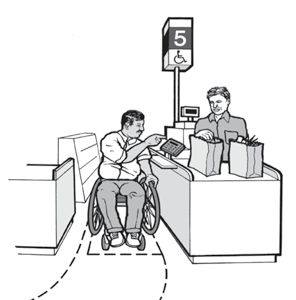Expanding Your Market: Maintaining Accessible Features in Retail Establishments
Accessible Route Into and Through the Business

An accessible route to a door with maneuvering clearance maintained on the door's latch side makes entry possible for the customer who uses a mobility device.
While accessible routes through a store are originally well-planned, promotional, seasonal, and other special displays that surround entrances and spill into aisles may substantially reduce their accessibility. Customers with disabilities will not be able to shop in a store if the route through an entry plaza is too narrow because of a display of snow blowers, if the maneuvering clearance alongside the entrance door is blocked by a sale book rack, or if a route contains scattered trip hazards from impulse items displayed on cloth-covered tables or in baskets on the floor.
Maintenance List
-
During business hours, unlock all doors at accessible entrances, even if they are not main entrances to the store. Mount clear, well-maintained signage at the main entrance to direct people to the accessible entrance.
-
If construction or repair requires customers to detour around taped-off areas or to step up on plywood walkways, ensure that the temporary route is accessible or that there is an alternate temporary accessible route with proper signage.
-
Ensure that boxes, vending machines, display racks, or other equipment do not block the maneuvering clearances required at the doors of accessible entrances. Arrange seasonal merchandise, baskets of impulse items, and extra clothes racks so that they do not block or protrude into the accessible route through the store.
-
Eliminate billowy, long table covers that spill into the accessible route. These create trip hazards for customers with low vision and snag under patrons' crutches, canes, and walkers and in their wheelchair wheels.
-
Plan all routes so that any hanging or mounted displays, wall-mounted shelving, lighting, or decorations provide required head clearance and cane detection for customers who are blind or have low vision.
-
Staff the accessible sales counters and check-out aisles during all business hours. These areas must have their aisles clear and their lowered counter spaces free of equipment and merchandise to be usable.
-
Ensure that accessible exits - including accessible emergency exits - are maintained at all times. Remove boxes, extra furniture, and other objects that may obstruct the route to the exits and the required door and floor clearances at them. Ensure that the doors have working accessible hardware and are unlocked during all business hours. If the store has evacuation equipment to assist people who cannot use stairs, make sure it is available, unobstructed, and in working condition.

Accessible checkout areas are connected to an accessible route and have sufficient clear floor space for a person using a wheelchair.

User Comments/Questions
Add Comment/Question